The Supposed Enigma of Isidore Francois Turgis
Harriet Beecher Stowe’s Uncle Tom’s Cabin was not just a hit in America, but also in France. After its publication slavery was considered a blight on history, at least in France’s liberal circles. Among those affected was Isidore Francois Turgis, a Catholic chaplain in Napoleon III’s army. He was age fifty-five and had seen the horrors of the Crimean War and the Second Italian War of Independence. Inspired by Stowe and the missionaries of the colonial era, Turgis set sail for New Orleans. He wanted to be a minister to the enslaved.
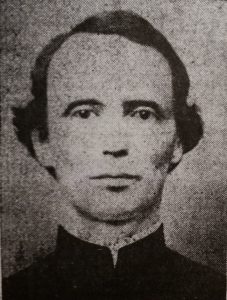
Turgis arrived in 1860. He was denied permission to minister to the slaves, but his experience and temperament impressed Archbishop Jean Marie Odin enough to see him posted as rector to the newly reconstructed St. Louis Cathedral. He came into a troubled congregation. Some priests and nuns had no love for slavery, and others deplored the slow erosion of the rights slaves had under the French and Spanish. Congo Square, where for decades slaves gathered on Sunday to sing, dance, play, and enjoy other recreations, was closed in the 1850s. By then many in the archdiocese were becoming firmly pro-slavery. Voodoo, once tolerated and even enjoying tacit support from the Catholics, was being suppressed. Odin led the way in pro-slavery sentiment in the church. He supported secession and the Confederacy.
Catholics increasingly became pro-slavery in the mold of the Anglo-Americans. Some of it was political. The Democrats were the party of Catholics as much as they were of slavery. That the Nativists, who controlled New Orleans from 1856-1862, were anti-Catholic furthered pro-slavery sentiment by driving Catholics into the Democratic Party. The Republicans were seen as worse for being both anti-slavery and sympathetic to anti-Catholic sentiments.
Turgis found himself in a city ripped apart by issues of race, religion, secession, class, and immigration, united mostly by being terrified of the growing power of the Republicans. Street violence, never rare in New Orleans, had been politicized. Brawls between gangs in service of either party were common and murder was never off the table. Add to that the high death rates from disease, particularly yellow fever, and New Orleans was a city of violence and death as much as it was of money, opulence, and vice.
In the secession craze, regiments were raised. Among them was the Orleans Guard, a unit of elite Creoles. P.G.T. Beauregard was briefly a member to show solidarity with his friends and relatives who were in the ranks. Leon Querouze, one of the city’s most powerful Creoles, commanded the infantry battalion of the Orleans Guard. On March 1, 1861 a special mass was held the St. Louis Cathedral to bless the unit’s colors. After Fort Sumter fell, Beauregard sent part of the fort’s flagpole to the Orleans Guard. It would carry their banner into battle. Odin designated Turgis as the unit’s chaplain.
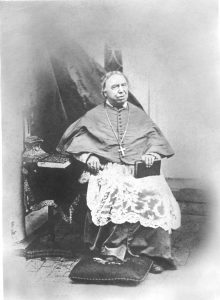
The average Creole of Louisiana was a liberal Catholic, many being Freemasons. They were not strict in observing religion and decried anything that looked like fanaticism or fantasy. Beauregard openly said that miracles did not exist, a not uncommon sentiment. Nearly all supported slavery to some degree or another.
Turgis put aside his known abolitionist sentiments to care for the men. They took a liking to him. He was direct and honest, which along with his abolitionism had made him unpopular among the city elite, but his unpretentious manner won over the men. The Journal of the Orleans Guard said of Turgis “He was a man who was excellent company for any one, and frank enough in his exhibition of character to escape any charge against him of hypocrisy.”[1] He did not discuss the morality or the cause of the war. His sermons emphasized the shared experience of soldiers. This resonated all the more when the Orleans Guard Battalion went north at Beauregard’s behest after the Confederate disasters in Kentucky and Tennessee. The sermons worked, and Turgis wrote to Odin on March 26, 1862 “I am aware of how you love the Creoles, who are returning sincerely to the good Lord on this day of trial.”[2]
The Orleans Guard Battalion saw its first action at Shiloh, like so many other regiments North and South. It had at most 300 in the ranks and nearly 100 would fall, some from friendly fire as they went into battle with blue uniforms on April 6, although they wore their coats inside out on April 7. Turgis, even after being wounded, stayed in the field tending to the wounded and the dying of both sides, applying first aid or last rites. Edmond Enoul Livaudais recalled “Father Turgis, was all the time by our side, with unceasing encouragement. During the battle he always maintained remarkable self-control.”[3] He remained modest, telling Odin after the battle “believe nothing that the young men have been able to say misleading about me, les Gardes d.Orleans are good to me, but they carry everything to exaggeration.”[4]
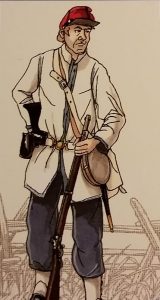
After Shiloh the Orleans Guard Battalion disbanded since they were a militia unit on loan. Many though went to the 30th Louisiana. Turgis followed the men, from Baton Rouge to the crucible of the Atlanta campaign and the final battles at Nashville and Spanish Fort.
At war’s end Turgis’ health was broken. He was unable to resume his duties at St. Louis Cathedral. Turgis was still venerated by the soldiers and officers, among them Beauregard and Querouze. They petitioned Odin to give Turgis a church. He was posted to the Church of St. Anthony of Puda Mortuary Chapel on Rampart Street. The church was not much in use, but it now became the chapel of choice for Confederate Creoles.
Turgis was active in other ways. He consoled the widows and children of men he had known. He became director of the Southern Hospital for invalid soldiers, administrator of the Marigny or “Beauregard” Asylum for the widows and orphans of deceased Confederates, and founded the Children of Mary sodality to raise money for charity.

The open support Turgis received was in contrast to another abolitionist priest, Father Claude Paschal Maistre. While Turgis went off to war, Maistre stayed in New Orleans. He led the large funeral for André Cailloux, a black officer of the 1st Louisiana Native Guards who died at Port Hudson. Maistre was censured by Odin, but he did not dare close St. Rose of Lima Church, which was in Maistre’s parish. In this dispute Turgis remained neutral, neither supporting Maistre nor approving Odin’s actions. It helped Turgis incur no wrath, and his chapel became a site where even Protestants, Jews, and atheists could meet with him. Nearly every night there were as many as twenty Confederates there to talk with Turgis.
In the summer 1867 there was a yellow fever epidemic. Turgis ministered to the sick, and it was said along with his other responsibilities, he had over exerted himself. He also had stomach cancer. On March 3, 1868 he died in the chapel’s rectory. His last words were “I have seen death so often that I do not fear it now.”[5] He was sixty-three, having spent thirty-eight as a priest.
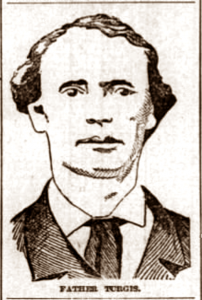
Veterans of the Army of Tennessee organized his funeral. He lay in state in the Mortuary Chapel before a funeral was held I St. Louis Cathedral. The funeral procession was reportedly the biggest in New Orleans up to that time, stretching at one point from Canal Street to St. Louis Cathedral. Beauregard led the march, and near him was Querouze and numerous other Creole officers. He was interned in St. Louis Cemetery No. 3 on Esplanade Avenue. Edward Lombard, a Protestant officer of the Point Coupee Battery, gave the eulogy and Odin observed the burial. Eventually a simple but unique monument was built for his remains, funded by his comrades in the 30th Louisiana.
For many it was the first time the Confederacy was honored in public. When Albert Sidney Johnson was transferred out of St. Louis Cemetery No. 2 in 1866, no pomp of any sort was allowed. This time, people were seen sporting gray, although compared to later Confederate ceremonies it was muted. In time some transformed Turgis into a local Lost Cause icon, but it never stuck. One could find no proclamations of a political nature, and his views on slavery were hardly unknown. The attendance for his funeral was dwarfed when Jefferson Davis died in New Orleans. John Perret in a 1908 oration at Turgis’ grave aptly called him “an alien to the cause of the Confederacy.”[6] Turgis’ ultimate cause was neither the Confederacy nor abolition, but soldiers, a group he knew well and seemed at home with. In that regard, he was only an enigma to those who saw the war through the narrow lens of abolitionism and the Lost Cause.
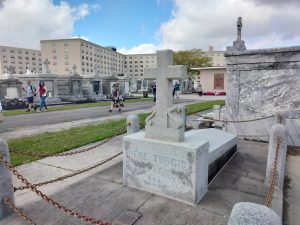
Turgis’ memory was mostly maintained by the veterans, and they often visited his grave. Such trips were made easier when a retirement for Confederate soldiers was built nearby. In the same area Beauregard was honored with a grand statue that sat near the cemetery from 1915-2017. As late as June 3, 1933, the Memorial Day of the South, veterans of the Army of Tennessee and the United Daughters of the Confederacy decorated his tomb. It might have been the last such event. As the 20th century wore on the grave became forgotten, save for the cemetery workers who clean it and the odd visitor to the cemetery who might notice the unusual tomb to a very unusual man.
Sources:
[1] Journal of the Orleans Guard, Historic New Orleans Collection
[2] Turgis to Odin, March 26, 1862, Archdiocese of New Orleans
[3] Edmond Enoul Livaudais, The Shiloh Diary of Edmond Enoul Livaudais. (New Orleans: Archdiocese of New Orleans, 1992), 31.
[4] Turgis to Odin, 16 April 1862, Archdiocese of New Orleans
[5] Celestin M. Chambon. In and Around the Old St. Louis Cathedral of New Orleans. (New Orleans: Philippe’s Printery, 1908), 130-131.
[6] The Daily Picayune June 4, 1908
Will dedicate a rosary to him. Thanks for this.
That is lovely.
Fascinating article about a relatively unknown French Catholic priest. Thanks for your effortsxin enlightening us. F. Norman Vickes, Pensacola CWRT
Very enlightening. The war and those involved in it was so complex. Despite the two sides being at war, there was great compassion everywhere.
Great work. Loved it. Would like to see more on the Vicentian Order to which Odin belonged and John Timon who was a close compatriot of Odins and who finally eliminaated slavery from Vicentian
stattions.